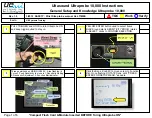
Thermo Fisher Scientific
Prima PRO & Sentinel PRO Mass Spectrometers User Guide
9-1
Chapter 9
Fault Diagnosis
This chapter provides information on basic fault diagnosis that
should only be undertaken by an experienced technician trained in
the maintenance of high voltage electronic equipment. The
information provided is not exhaustive, and normal diagnostic
procedures should be followed where specific details are not given.
The status of the instrument is indicated in GasWorks software by
the status window display. Any out of limit condition for any
parameter is indicated by an alarm condition (normally indicated in
red). Typical values, limits, and causes of alarm conditions are
indicated in the table below.
Table 9
–1.
Diagnosing alarm conditions
Device
Typical
Reading
Set Point
Low
Set Point
High
Typical Cause
Electron Energy
70.10 volts
30.00 volts
95.00 volts
ASU failure
Emission
1
0.5
1.5
Power parameters in
alarm
Filament Current
2.60 amps
1.50 amps
3.50 amps
Still pumping down or
filament failure
Filament Current Limit
3.06 amps
Filament Integrity
(OK)
Half Plate 1 Output
Voltage
448.0 volts
300.0 volts
950.0 volts
ASU failure
Half Plate 2 Output
Voltage
431.0 volts
300.0 volts
950.0 volts
ASU failure
In Current Limit
(OK)
(OK)
Ion source fault
Ion Energy
998.0 volts
750.0 volts
1050.0
volts
ASU failure
Repeller Voltage
6.96 volts
-10.00
volts
10.00 volts
ASU failure
Source Current
85.0
µamps
1000.0
µamps
Faulty filament
Source Temperature
140.1°C
138.0°C
142.0°C
Still warming up or
source heater failure
Trap Current
29.9
µamps
10.0
µamps
100.0
µamps
Filament failure
Introduction
Alarm
Conditions
















































